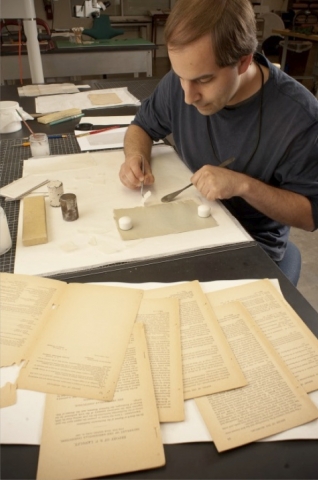The Joseph F. Cullman 3rd Endowment for the Preservation of Natural History Rare Books
 |
| Joseph F. Cullman 3rd |
The Joseph F. Cullman 3rd Endowment for the Preservation of Natural History Rare Books was created by Mr. Cullman in 1998.
Joseph F. Cullman 3rd, was the former Chairman Emeritus and Chairman and Chief Executive Officer of Philip Morris Incorporated. Mr. Cullman was a committed outdoorsman, conservationist and philanthropist, serving as chairman of the Atlantic Salmon Federation and on the board of the World Wildlife Fund. He also formed the Cullman Wildlife Project in Tanzania. In addition, Mr. Cullman served as Chairman of the U.S. Open Tennis Championship and as Chairman of the Tennis Hall of Fame. During World War II, Mr. Cullman distinguished himself as a U.S. Navy commander in the Pacific. He was awarded a Commendation Ribbon with seven stars for his service
 |
| Don Stankavage works with Natural History rare books at the Smithsonian Libraries’ Book Conservation Lab. |
Mr. Cullman said he made the gift primarily because of his great longtime respect and affection for Dillon Ripley and the Smithsonian. Ripley, Smithsonian Secretary, 1964-1984, was a prominent ornithologist who, among his many other accomplishments, assembled the Smithsonian's disparate libraries into a cohesive system which today consists of a central administration and twenty branch libraries. Mr. Cullman was a generous supporter of the Smithsonian for many years. He was a founding member of the Smithsonian National Board. The creation of this endowment was especially meaningful to the Libraries, as collections preservation is one of the Libraries' highest priorities.
“The Smithsonian Libraries’ collection of rare books on botany, zoology, anthropology and the other natural sciences is a national treasure, a joy to work with, and a tremendous responsibility; it is our job to make the books available to researchers and to keep them in good enough condition to be used both now and into the future. Books from the hand-press period (roughly 1450-1840) are generally strong and durable and will last hundreds more years if properly cared for, but careless use, poor storage, and inappropriate repairs in the past often result in damage that can ultimately render the book un-usable. The Preservation Endowment for natural-history rare books provides funds for conservation treatments that range from constructing simple archival enclosures for fragile bindings, to full-scale dis-binding, de-acidifying, re-sewing, and re-binding. It allows us to supplement the staff at our Book Conservation Laboratory by bringing in outside conservators and technicians for specific projects, and to expand our in-house capabilities by acquiring specialized equipment and supplies.”
Leslie K. Overstreet, Curator
Natural History Rare Books
